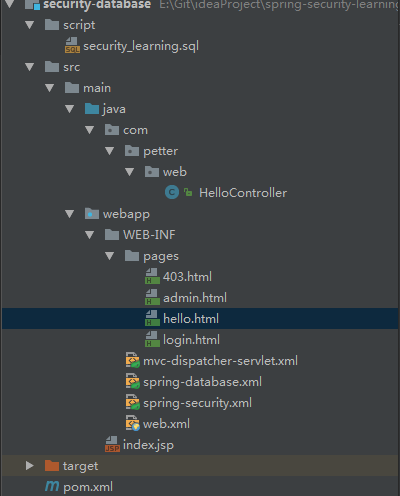之前的用户信息我们都是使用的内存用户,测试例子可以,实际中使用肯定不行,需要结合数据库进行验证用户。这就是本节的重点:
项目目录如下:

在之前的项目中的依赖中添加两个依赖:
<dependency> <groupId>org.springframework</groupId> <artifactId>spring-jdbc</artifactId> <version>${spring.version}</version> </dependency> <!-- 用于thymeleaf中使用security的标签 --> <dependency> <groupId>org.thymeleaf.extras</groupId> <artifactId>thymeleaf-extras-springsecurity4</artifactId> <version>3.0.2.RELEASE</version> </dependency> <!-- mysql --> <dependency> <groupId>mysql</groupId> <artifactId>mysql-connector-java</artifactId> <version>${mysql.connector.version}</version> </dependency>
spring-jdbc依赖用于数据库查询,thymeleaf-extras-springsecurity4是thymeleaf对security标签的支持
在数据库中添加两张表:
CREATE TABLE users ( username VARCHAR(45) NOT NULL , password VARCHAR(45) NOT NULL , enabled BOOLEAN DEFAULT TRUE NOT NULL, PRIMARY KEY (username) ); CREATE TABLE user_roles ( user_role_id int(11) NOT NULL AUTO_INCREMENT, username varchar(45) NOT NULL, role varchar(45) NOT NULL, PRIMARY KEY (user_role_id), UNIQUE KEY uni_username_role (role,username), KEY fk_username_idx (username), CONSTRAINT fk_username FOREIGN KEY (username) REFERENCES users (username) ); INSERT INTO users(username,password,enabled) VALUES ('hxf','123456', true); INSERT INTO users(username,password,enabled) VALUES ('wpp','123456', true); INSERT INTO user_roles (username, role) VALUES ('hxf', 'ROLE_USER'); INSERT INTO user_roles (username, role) VALUES ('hxf', 'ROLE_ADMIN'); INSERT INTO user_roles (username, role) VALUES ('wpp', 'ROLE_USER');
这里参考 http://docs.spring.io/spring-security/site/docs/4.2.1.RELEASE/reference/htmlsingle/#user-schema 官网给的配置
一、添加数据库配置文件spring-database.xml
<?xml version="1.0" encoding="UTF-8"?> <beans xmlns="http://www.springframework.org/schema/beans" xmlns:xsi="http://www.w3.org/2001/XMLSchema-instance" xsi:schemaLocation="http://www.springframework.org/schema/beans http://www.springframework.org/schema/beans/spring-beans.xsd http://www.springframework.org/schema/security http://www.springframework.org/schema/security/spring-security.xsd"> <bean id="datasource" class="org.springframework.jdbc.datasource.DriverManagerDataSource"> <property name="driverClassName" value="com.mysql.jdbc.Driver"/> <property name="url" value="jdbc:mysql://localhost:3306/security_learning"/> <property name="username" value="petter"/> <property name="password" value="petter"/> </bean> </beans>
添加完成以后需要在web.xml文件中指定:
<!-- Loads Spring config file --> <context-param> <param-name>contextConfigLocation</param-name> <param-value> /WEB-INF/spring-security.xml /WEB-INF/spring-database.xml </param-value> </context-param>
二、修改spring-security.xml配置文件:
<?xml version="1.0" encoding="UTF-8"?> <beans xmlns="http://www.springframework.org/schema/beans" xmlns:xsi="http://www.w3.org/2001/XMLSchema-instance" xmlns:security="http://www.springframework.org/schema/security" xsi:schemaLocation="http://www.springframework.org/schema/beans http://www.springframework.org/schema/beans/spring-beans.xsd http://www.springframework.org/schema/security http://www.springframework.org/schema/security/spring-security.xsd"> <!-- use-expressions 允许使用表达式 --> <security:http auto-config="true" use-expressions="true"> <security:intercept-url pattern="/admin**" access="hasRole('ROLE_ADMIN')"/> <!-- 拒绝访问页面 --> <security:access-denied-handler error-page="/403"/> <security:form-login login-page="/login" default-target-url="/welcome" authentication-failure-url="/login?error" username-parameter="user-name" password-parameter="pwd"/> <security:logout logout-success-url="/login?logout"/> <!-- XML 配置中默认csrf是关闭的,此处设置为打开 如果这里打开csrf,则在form表单中需要添加 <input type="hidden" th:name="${_csrf.parameterName}" th:value="${_csrf.token}" /> --> <security:csrf /> </security:http> <security:authentication-manager> <security:authentication-provider> <security:jdbc-user-service data-source-ref="datasource" users-by-username-query="select username,password, enabled from users where username = ?" authorities-by-username-query="select username, role from user_roles where username = ?"/> </security:authentication-provider> </security:authentication-manager> </beans>
三、修改登录以后默认进入的页面hello.html
<!DOCTYPE html> <html xmlns="http://www.w3.org/1999/xhtml" xmlns:th="http://www.thymeleaf.org" xmlns:sec="http://www.thymeleaf.org/thymeleaf-extras-springsecurity4"> <head> <meta charset="UTF-8" /> <title>hello</title> </head> <body> <h1 th:text="|标题: ${title}|">Title : XXX</h1> <h1 th:text="|信息: ${message}|">Message : XXX</h1> <div sec:authentication="name"> 验证用户的名称显示在这里 </div> <div sec:authentication="principal.authorities"> 验证用户的权限显示在这里 </div> <!-- 下面注释掉的两种写法是等价的,但是不起作用,暂时使用第三种方式 --> <!--<div sec:authorize="hasRole('ROLE_USER')">--> <!--<div sec:authorize="hasAuthority('ROLE_USER')">--> <div th:if="${#strings.contains(#authentication.principal.authorities,'ROLE_USER')}"> <form action="/logout" method="post" id="logoutForm"> <input type="hidden" th:name="${_csrf.parameterName}" th:value="${_csrf.token}" /> </form> <h2><a href="javascript:formSubmit()">退出</a></h2> <script> function formSubmit() { document.getElementById("logoutForm").submit(); } </script> </div> </body> </html>
这里需要注意:
1、由于采用的是thymeleaf模板,所有不能使用spring security的标签库,需要使用thymeleaf扩展的库,即pom文件中添加的依赖thymeleaf-extras-springsecurity4
2、在mvc-dispather-servlet.xml文件修改配置把库加入:
<bean id="templateEngine" class="org.thymeleaf.spring4.SpringTemplateEngine"> <property name="templateResolver" ref="templateResolver"/> <property name="additionalDialects"> <set> <!-- Note the package would change to 'springsecurity3' if you are using that version --> <bean class="org.thymeleaf.extras.springsecurity4.dialect.SpringSecurityDialect"/> </set> </property> </bean>
3、如上注释所示,两种写法判断只用含有USER角色的用户会显示,不起作用,可能只会会修复。
PS:要想起作用,thymeleaf-spring4 版本必须是 3.0.3.RELEASE以上
记住,role就是一种约定的前面加上ROLE_作为前缀的特殊的authority,所以它们是等价的,具体可以参考http://stackoverflow.com/questions/19525380/difference-between-role-and-grantedauthority-in-spring-security
四、添加403.html页面
<!DOCTYPE html> <html xmlns:th="http://www.thymeleaf.org"> <head> <meta charset="UTF-8"/> <title>403</title> </head> <body> <h1>HTTP Status 403 - Access is denied</h1> <div> <h2 th:if="username eq null" th:text="您没有权限访问这个页面"></h2> <h2 th:if="username ne null" th:text="|用户:${username},您没有权限访问这个页面|"></h2> </div> </body> </html>
并且在HelloController中添加代码:
@RequestMapping(value = "/403", method = RequestMethod.GET) public ModelAndView accessDenied() { ModelAndView model = new ModelAndView(); //检查用户是否已经登录 Authentication auth = SecurityContextHolder.getContext().getAuthentication(); if (!(auth instanceof AnonymousAuthenticationToken)) { UserDetails userDetail = (UserDetails) auth.getPrincipal(); model.addObject("username", userDetail.getUsername()); } model.setViewName("403"); return model; }
启动程序,访问http://localhost:8080/login http://localhost:8080/admin 登录不同角色的用户进行自行测试